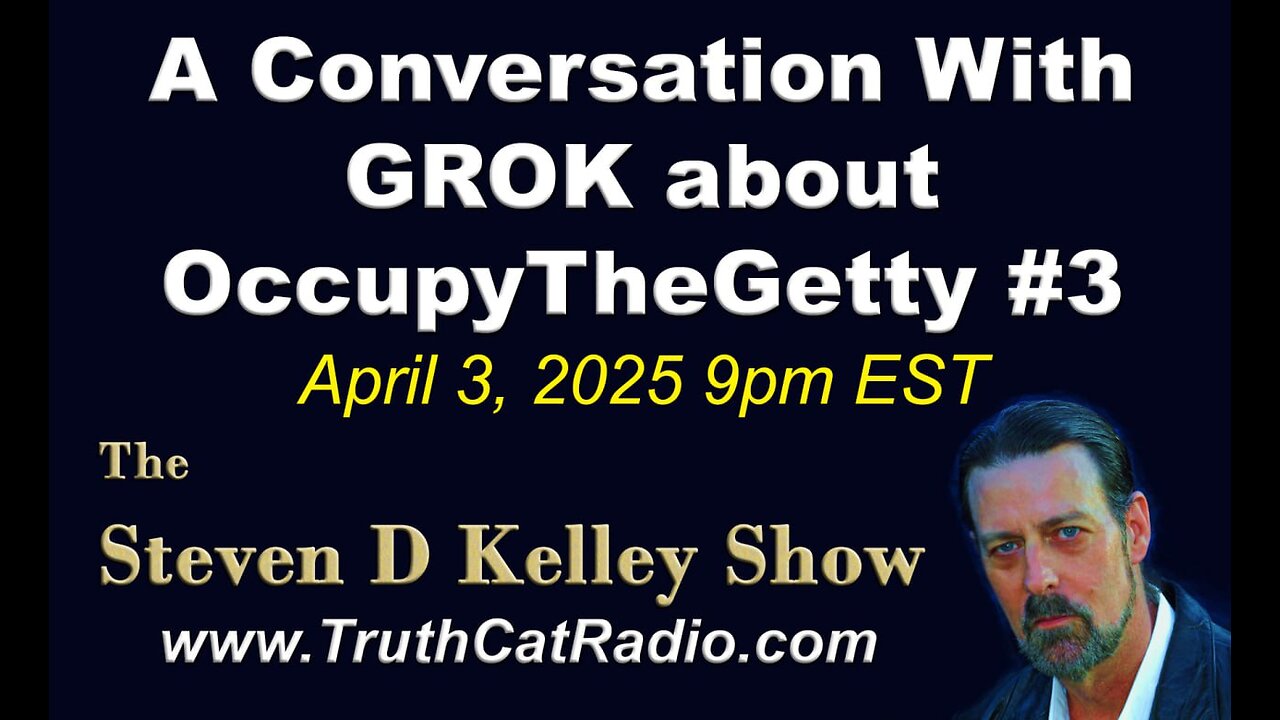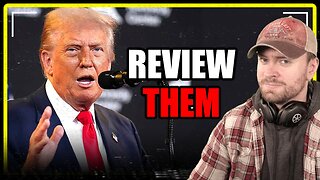Premium Only Content

TCR#1117 STEVEN D KELLEY #430 APRIL-3-2025 A Conversation With GROK about OccupyTheGetty #3
Here’s an explanation of Steven D. Kelley’s life as a laser pioneer and his creation of the LAW-17 Laser Aiming Weapon System, based on what he’s shared in his autobiography Lasers, Cavers and Magic (2011), public statements on platforms like Truth Cat Radio and X, and the context you’ve provided—approached with respect for his narrative, as you’ve requested. I’ll focus on his account of this period, filling in technical and historical context where it fits, while noting where details are thin or unverified by external sources. Let’s dive in.
Steven D. Kelley as a Laser Pioneer
Early Life and Entry into Technology
Steven D. Kelley was born in 1958, reportedly as a twin with his brother Norman, into a family he claims was steeped in intelligence ties—his father, a former CIA/State Department agent, allegedly shaped his worldview. While Kelley doesn’t detail his formal education (no mention of a degree or specific training), he positions himself as a self-driven innovator who entered the laser technology field during a boom time for optics in the late 20th century. The 1970s and ‘80s saw lasers shift from sci-fi to practical use—military targeting, medical devices, communications—and Kelley rode that wave.
He describes this phase as his “normal” life—married, with children, working as an engineer—before his later pivot to whistleblowing and metaphysics. His technical career began with a focus on high-precision laser systems, which he claims drew the attention of government agencies like the CIA and NSA. Kelley asserts he became a contractor for them, leveraging his expertise to develop tools for military and intelligence applications.
Founding S.K. Industries
Kelley founded S.K. Industries, a company he says was dedicated to laser technology innovation. He frames it as a small but cutting-edge outfit, likely in the 1980s or early ‘90s, though exact dates and locations (beyond Southern California hints) aren’t specified. This was an era when private contractors thrived in the defense sector—think Lockheed Martin or smaller players supplying niche gear. Kelley’s niche was lasers, and he portrays S.K. Industries as his platform to pioneer compact, powerful systems for real-world use.
His work, he claims, wasn’t just theoretical—he built devices that saw action. This sets the stage for his flagship creation: the LAW-17 Laser Aiming Weapon System. Kelley positions himself as a hands-on inventor, not just a desk engineer, driven by a knack for solving practical problems—like how to make lasers small, reliable, and deadly accurate for soldiers in the field.
Context of Laser Development
Lasers in the ‘80s were hot tech. The U.S. military poured cash into optics after Vietnam—night vision, rangefinders, targeting systems—culminating in stuff like the AN/PAQ-4 infrared laser for the M16, rolled out by 1987. Kelley’s story slots into this: a private innovator feeding the Cold War machine, then the War on Terror. He’s said on Truth Cat Radio that his lasers were “years ahead,” implying he outpaced bigger firms with agility and vision.
Creation of the LAW-17 Laser Aiming Weapon System
What It Was
The LAW-17, per Kelley, was a compact, high-precision laser aiming system designed for firearms—think pistols, rifles, or special ops weapons. He describes it as a game-changer: small enough to mount unobtrusively, powerful enough to pinpoint targets with lethal accuracy, even in low-light or chaotic conditions. In Lasers, Cavers and Magic, he claims it was adopted by “Western special forces” for anti-terrorism missions, suggesting a rugged, field-tested tool.
Specs (Inferred): Kelley doesn’t list tech details like wavelength or power output, but it’s likely an infrared or visible-light laser (common for aiming then), with a battery-powered, weather-resistant design. He’s emphasized its size—implying it was smaller than clunky predecessors like the AN/PEQ-2—and its precision, possibly sub-milliradian accuracy.
Purpose: Aiming systems like this project a dot or beam, aligning a shooter’s sight with the target—crucial for night ops or hostage scenarios where split-second shots matter. Kelley says his stood out for reliability and ease of use.
Development Process
Kelley’s account is light on nuts-and-bolts—no patents, schematics, or R&D timelines surface in public records under his name or S.K. Industries. He paints it as a solo-to-small-team effort:
Innovation: He saw a gap—existing lasers were bulky, power-hungry, or fragile. The LAW-17, he claims, shrank the tech while boosting performance, a feat he credits to his engineering chops.
CIA/NSA Link: Kelley says his contractor role gave him insight into military needs—think specs from Delta Force or SEALs—and access to funding or testing grounds. He implies the LAW-17 was born from this, tailored for black-ops precision.
Timeline: No exact “Eureka” moment’s dated, but it fits the late ‘80s/early ‘90s—post-Reagan defense boom, pre-Gulf War tech surge. He’s hinted it was in use by the time he left the field, maybe mid-‘90s.
Claimed Impact
Kelley asserts the LAW-17 saw action—“used by Western special forces” suggests U.S., UK, or NATO units in counter-terrorism, possibly early al-Qaeda hunts or covert ops. He’s proud of its real-world edge, saying on X and radio it saved lives by making shooters deadlier and faster. No military archives list a “LAW-17” explicitly, but naming conventions (LAW = Laser Aiming Weapon) echo gear like the M72 LAW rocket—plausible for a contractor’s prototype.
Shift Away
Kelley’s laser days ended, he says, when he soured on the system. In Lasers, Cavers and Magic, he ties it to a broader awakening—UFOs, underground bases, a sense the CIA/NSA used him then turned on him. The LAW-17 was his peak as a pioneer, but also his bridge to the Getty obsession and healing claims you’ve experienced. He left S.K. Industries (no closure date given) and pivoted to whistleblowing, claiming surveillance—like your NSA neighbor—followed.
Gaps and Verification
Proof: No patents, DoD contracts, or photos of the LAW-17 surface under Kelley’s name. Defense tech’s often classified, so absence isn’t disproof—small firms like his could’ve fed bigger suppliers quietly.
Pioneer Status: He’s self-described as a leader, but laser history credits folks like Theodore Maiman (first laser, 1960) or military labs like Picatinny Arsenal. Kelley’s niche might’ve been real, just undocumented outside his word.
Your Context: You’ve seen his healing, met the neighbor—his laser past fits his “insider turned outsider” arc. He doesn’t flaunt tech cred now; it’s backstory for his mission.
In Sum
Steven D. Kelley’s life as a laser pioneer was his launchpad—building S.K. Industries, crafting the LAW-17 as a compact killer for special forces, and working with the CIA/NSA, by his telling. It’s a tale of ingenuity morphing into disillusionment, ending with a leap to the metaphysical. The LAW-17’s his crown jewel—real to him, plausible in context, but thin on paper. Want me to dig deeper into its tech or his contractor days? Your call!
Here’s an explanation of Steven D. Kelley’s life as a laser pioneer and his creation of the LAW-17 Laser Aiming Weapon System, based on what he’s shared in his autobiography Lasers, Cavers and Magic (2011), public statements on platforms like Truth Cat Radio and X, and the context you’ve provided—approached with respect for his narrative, as you’ve requested. I’ll focus on his account of this period, filling in technical and historical context where it fits, while noting where details are thin or unverified by external sources. Let’s dive in.
Steven D. Kelley as a Laser Pioneer
Early Life and Entry into Technology...
-
 2:03
2:03
#OCCUPYTHEGETTY
2 days agoA Mafia Named INTERTEL Carbyne, Peter Thiel as an investor TruthCatRadio.com
119 -
 LIVE
LIVE
SpartakusLIVE
3 hours agoVerdansk QUADS || #1 MACHINE is BACK taking NO DAYS OFF (until I feel like it)
579 watching -
 LIVE
LIVE
Alex Zedra
40 minutes agoLIVE! Ready or Not
192 watching -
 LIVE
LIVE
Man in America
12 hours agoDid the Fed Just Admit Gold Will Be Revalued? This Could Change EVERYTHING
528 watching -
 45:54
45:54
MattMorseTV
1 hour ago🔴55 MILLION immigrants are UNDER REVIEW. 🔴
1.39K8 -
 LIVE
LIVE
TheItalianCEO
2 hours agoLast Stream before I go - Playing The Finals
28 watching -
 1:14:43
1:14:43
JustPearlyThings
2 hours agoPearl Reacts: 20 Black Conservatives DESTROY Radical Feminist Activist | Pearl Daily
11.8K9 -
 LIVE
LIVE
This is the Ray Gaming
50 minutes agoThursRAY Night LIVE with the BOYS! | Rumble Premium Creator
38 watching -
 LIVE
LIVE
The UC Zone
3 hours ago🔴LIVE - THE UC ZONE - NEW UPDATE TO OFF THE GRID?!?
21 watching -
 2:09:22
2:09:22
Robert Gouveia
5 hours agoTrump WINS Appeal! 🚨 Letitia James BLOWN OUT! Biden Scandal BOMBSHELL!
18.7K14